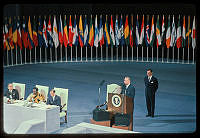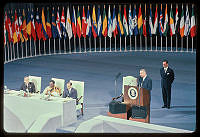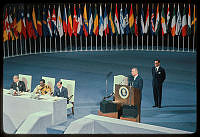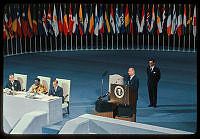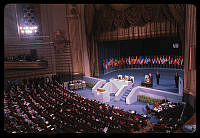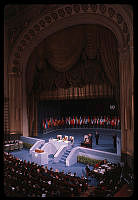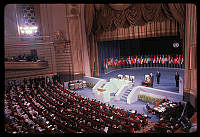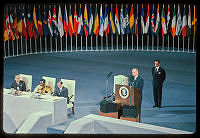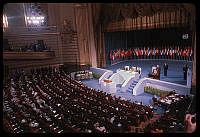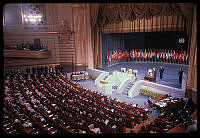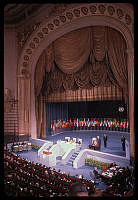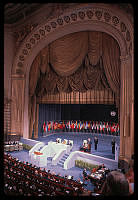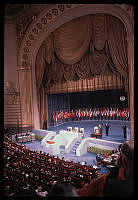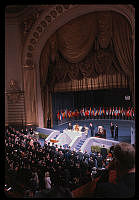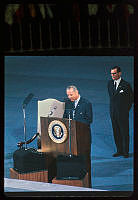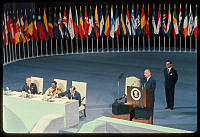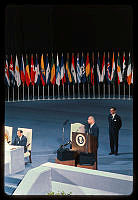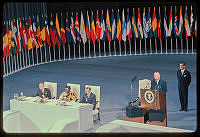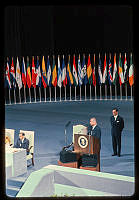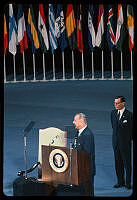Rescue of the Papers of State During the Burning of Washington
Copyright © Summer 2014 White House Historical Association. All rights reserved under international copyright conventions. No part of this article may be reproduced or utilized in any form or by any means, electronic or mechanical, including photocopying, recording, or by any information storage and retrieval system, without permission in writing from the publisher. Requests for reprint permissions should be addressed to books@whha.org

“You had better remove the records” is the ominous conclusion of James Monroe’s message to James Madison on August 22, 1814
In August 1814, British forces occupying the Chesapeake Bay began to sail up the Patuxent River in Maryland. Fearing an attack on the capital, Secretary of State James Monroe offered to scout the British position and report back to President James Madison. Monroe, accompanied by cavalry, left Washington and rode into southern Maryland.
On August 19 and 20 the British landed troops at the port town of Benedict, Maryland, and started advancing north. By August 22, it became clear to Monroe that the British intended to invade Washington. He quickly dispatched a messenger with a note to President Madison, saying: “The enemy are advanced six miles on the road to the Woodyard, and our troops retiring. Our troops were on the march to meet them, but in too small a body to engage. . . . The enemy are in full march for Washington. Have the materials prepared to destroy the bridges.” In a postscript, Monroe added: “You had better remove the records.”1
Before Congress created the National Archives in 1934, it required each executive department to keep its own archives. Congress gave the Department of State the important task of safeguarding the nation’s early state papers—treasured documents including the records of the Confederation and Continental Congresses, George Washington’s papers as commander of the Continental Army, the Declaration of Independence, and the Constitution.

The British column was led by Major General Robert Ross from Benedict, Maryland, into the City of Washington where they would burn the Capitol, the White House, and other public buildings. This map was published in 1818 to illustrate Ross’s route.
As the United States government moved from New York to Philadelphia and eventually to Washington, D.C., the government’s papers traveled with each department. Once in Washington, the papers were stored in boxes and trunks in the cramped attics of public buildings scattered throughout the city. The records were at risk from poor storage conditions and lack of suitable space, as well as neglect, theft, and fire. But perhaps the most striking example of the peril faced by the state papers occurred as British troops approached Washington in August 1814.
Word of a British invasion sent Washington citizens into a frenzy. Local residents fled, turning the city’s supply of horses, wagons, and carts into priceless commodities. Government agents trying to save as many federal records as possible scrambled to secure any remaining means of transport. Some government clerks even tried using their official positions to impound carts and wagons, but had little success in persuading residents who were busy moving their personal belongings out of the city.
At the Department of State, clerks John Graham, Stephen Pleasanton, and Josias King took up the task of saving the valuable archives in the department’s custody. The clerks bought coarse linens to make bags into which they stuffed the archives and then loaded the bags onto carts. The documents they packed included the books and papers of the State Department, unpublished secret journals of Congress, George Washington’s commission and correspondence, the Articles of Confederation, the papers of the Continental Congress, and treaties, laws, and correspondence dating back to 1789. Along with these early records, the clerks also bagged up the Constitution, Declaration of Independence, and Bill of Rights.

Clerk Stephen Pleasanton helped to save the Constitution, Declaration of Independence, and Bill of Rights when the British were marching toward Washington, D.C., in 1814.
Few contemporary accounts of the evacuation from Washington exist, and most of what is known about the events was recorded years later. According to Pleasanton, whose account was taken thirty-four years afterward, the clerks first took several document-loaded carts to a vacant gristmill on the Virginia side of the Potomac River, located a couple of miles above Georgetown. Across the river on the Maryland side was a foundry that made munitions for the war, and the clerks feared it might become a British target and bring the enemy too near their precious cargo. Pleasanton recounted that he considered “the papers unsafe at the Mill, as, if the British forces got to Washington, they would probably detach a force for the purpose of destroying a foundry for canon and shot in its neighbor hood, and would be led by some evil disposed person to destroy the Mill and papers.”2
Pleasanton decided to find another location. After obtaining wagons from nearby farmers, the clerks moved the documents to Leesburg, Virginia, about 35 miles outside of Washington. There they locked the valuable documents in a cellar vault of an abandoned house and gave the keys to Leesburg’s sheriff for safekeeping.
At the White House, First Lady Dolley Madison waited nervously for her husband. The president had warned her to be ready to evacuate at a moment’s notice. She had “pressed as many Cabinet papers into trunks as to fill one carriage; our private property must be sacrificed, as it is impossible to procure wagons for its transportation.”3 When word of the imminent invasion finally reached the White House, the carriage containing the cabinet papers and other valuables left for the Bank of Maryland in Baltimore.
Before leaving herself, Mrs. Madison famously insisted that the Gilbert Stuart painting of George Washington be removed to prevent it from falling into the hands of the British. Once Mrs. Madison felt assured the painting would be safe, she fled west into Virginia.

The British column was led by Major General Robert Ross from Benedict, Maryland, into the City of Washington where they would burn the Capitol, the White House, and other public buildings.
The absence of such prudence jeopardized the papers of Congress, which were stored in the Capitol Building. By the time the young clerks of the U.S. House of Representatives and the U.S. Senate offices took action, it was too late to rescue all of the records. After finally obtaining a cart and oxen, House clerks Samuel Burch and J. T. Frost frantically moved House papers to a secret location in the countryside 9 miles outside of the city. The Senate clerk Lewis Machen took a wagonload of Senate documents to his farm in Prince Georges County, Maryland.
The House and Senate clerks knew they had left valuable materials behind in the chaos. Machen noted that he loaded what he considered the most valuable documents, including confidential papers, “one of which I knew to contain the number and positions of the entire American military force,” and what he believed constituted the only copy of the Senate’s history over the past quarter century.4 Burch and Frost also salvaged as many of the House’s most important papers as they could but expressed their frustration that more could have been saved: “Everything belonging to the office, together with the Library of Congress, we venture to say, might have been removed in time, if carriages could have been procured; but it was altogether impossible to procure them, either for hire, or by force.”5
While the state papers were being carted off to various locations in Maryland and Virginia, the British forces advanced to Bladensburg, Maryland. The Americans’ feeble attempt to hold back British troops at the Battle of Bladensburg ended in swift defeat. The British invaders then marched, unimpeded, into the city from the northeast, intent on destroying as many public buildings as possible. When they arrived around 8:00 p.m., they found Washington nearly abandoned. Congress had recessed for the summer, the cabinet had dispersed, and President Madison, after a brief appearance at the front lines, had retreated to Virginia. The vast majority of other residents had fled to the countryside.

A View of the Capitol After the Conflagration of the 24th August 1814, engraved by William Strickland after a watercolor by George Munger, 1814.
In the near-vacant city, British troops vandalized and set fire to the unfinished Capitol Building—which also housed the Library of Congress and the Supreme Court. The troops then marched up Pennsylvania Avenue, burning and looting the White House and nearby government buildings, including those housing the Departments of State, War, and Navy, and the Treasury Building. A few miles southeast, over at the Navy Yard, the commandant had ordered clerks to torch ships and ammunitions to prevent the British from procuring them. The collective blaze reportedly could be seen as far away as Baltimore.

The National Archives building under construction on Pennsylvania Avenue, 1935.
National Archives and Records AdministrationThe attack, coupled with a devastating storm on August 25, destroyed most of Washington’s public buildings. Although many records had been evacuated, the British destroyed or removed nearly all the government papers that had remained in the city. When President Madison returned to the ruined city, he lambasted the British forces for wantonly destroying “depositories of the public archives, not only precious to the nation as the memorials of its origin and its early transactions, but interesting to all nations as contributions to the general stock of historical instruction and political science.”6
In addition to the extensive physical damage, the attack struck a great emotional blow to the nascent city. Government officials questioned whether Washington should remain the capital, and some called for it to be abandoned. Members of Congress debated whether the capital should move to someplace “with greater security and less inconvenience” than Washington.7 Ultimately, Congress decided to remain in the city and appropriated funds to repair and rebuild the White House, Capitol, and public offices on their present sites.
Even though the British occupation destroyed some of the nation’s most important documentary heritage, Congress’s plans to rebuild the city did not include provisions for a national archives. Over the next hundred years, many of the nation’s most valuable state papers continued to endure poor storage conditions, lack of suitable space, constant shuffling around the city, and a near-constant threat of fire. Miraculously, many of the state papers survived until their eventual transfer to the National Archives, where they are now properly preserved and accessible to the American public.

In the years before it was enshrined in the Archives, the Declaration of Independence was moved many times. It originally moved with the nations government and settled in Washington, D.C. It has been housed in the Patent Office, Library of Congress, and State, War, and Navy Building, before being moved to Fort Knox during World War II. After the war it was returned to the Library of Congress and today can be seen on display in the rotunda of the National Archives
Library of Congress












